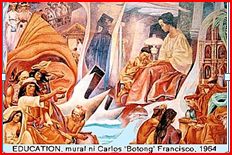A National Artist of the Philippines is a title given to a Filipino who has been given the highest recognition for having made significant contributions to the development of Philippine arts. Such Filipinos are announced, by virtue of a Presidential Proclamation, as National Artist or in Filipino, Gawad Pambansang Alagad ng Sining. They are then conferred membership in the Order of National Artists, the regalia of which is an ornate, gilden collar of honor. In addition to the collar, each newly proclaimed member of the Order is given a citation that is presented during the awardees' conferment ceremonies. The Cultural Center of the Philippines then hosts a Memorabilia Exhibit and Gabi ng Parangal (A Night of Tributes) for the National Artists at the Tanghalang Pambansa.
 Levi Celerio (April 30, 1910 - April 2, 2002) was a Filipino composer and lyricist who was born in Manila, Philippines. Celerio was a prolific song-writer, with over 4,000 songs to his credit. He is perhaps best-known for being a leaf-player, a feat for which he was put into the Guinness Book of World Records. In 1997, he was named National Artist of the Philippines for Music.
Levi Celerio (April 30, 1910 - April 2, 2002) was a Filipino composer and lyricist who was born in Manila, Philippines. Celerio was a prolific song-writer, with over 4,000 songs to his credit. He is perhaps best-known for being a leaf-player, a feat for which he was put into the Guinness Book of World Records. In 1997, he was named National Artist of the Philippines for Music.Catalino Ortiz Brocka (April 3, 1939–May 21, 1991) is known as one of the greatest film directors of the Philippines. Brocka was openly homosexual and many of his films incorporated LGBT themes into their often dramatic storylines.
 Brocka was born in Pilar, Sorsogon. He directed his first film, Wanted: Perfect Mother, based on The Sound of Music and a local comic serial, in 1970. It won an award for best screenplay at the 1970 Manila Film Festival. Later that year he also won the Citizen’s Council for Mass Media's best-director award for the film Santiago!
Brocka was born in Pilar, Sorsogon. He directed his first film, Wanted: Perfect Mother, based on The Sound of Music and a local comic serial, in 1970. It won an award for best screenplay at the 1970 Manila Film Festival. Later that year he also won the Citizen’s Council for Mass Media's best-director award for the film Santiago!In 1974 Brocka directed Tinimbang Ka Ngunit Kulang (Weighed But Found Wanting), which told the story of a teenager growing up in a small town amid its petty and gross injustices. It was a box-office hit, and earned Brocka another best-director award, this time from the Filipino Academy of Movie Arts and Sciences (FAMAS).
Carlos V. Francisco (November 4, 1912 – March 31, 1969), popularly known as Botong, was a muralist from Angono, Rizal.
 Francisco was a most distinguished practitioner of mural painting for many decades and best known for his historical pieces. He was one of the first Filipino modernists along with Galo Ocampo and Victorio C. Edades who broke away from Fernando Amorsolo's romanticism of Philippine scenes. According to restorer Helmuth Josef Zotter, Francisco's art "is a prime example of linear painting where lines and contours appear like cutouts."
Francisco was a most distinguished practitioner of mural painting for many decades and best known for his historical pieces. He was one of the first Filipino modernists along with Galo Ocampo and Victorio C. Edades who broke away from Fernando Amorsolo's romanticism of Philippine scenes. According to restorer Helmuth Josef Zotter, Francisco's art "is a prime example of linear painting where lines and contours appear like cutouts."His great works include Blood Compact, First Mass at Limasawa, The Martyrdom of Rizal, Bayanihan, Magpupukot, Fiesta, Bayanihan sa Bukid, Sandugo, Portrait of Purita, The Invasion of Limahong, Serenade, and Muslim Betrothal. Some of his murals have suffered damage over the years. The "Pageant of Commerce" emerged from several years of restoration in 2000. His murals in the lobby of the Philippine General Hospital were restored for the 3rd time in 2007.
He was also responsible for the discovery of the now famous Angono Petroglyphs in 1965. He was also involved in Costume Design in Philippine cinema.
He died in poverty from tuberculosis but he was given the highest recognition, the title National Artist of the Philippines - Visual Arts posthumously in 1973.
Victorio C. Edades (December 13, 1895 - March 7, 1985) is a Filipino painter who was the leader of the revolutionary Thirteen Moderns who engaged their classical compatriots in heated debate over the nature and function of art. He was named a National Artist in 1976.
Fernando Amorsolo y Cueto (May 30, 1892 – April 24, 1972) is one of the most important artists in the history of painting in the Philippines. Amorsolo was a portraitist and painter of rural Philippine landscapes. He is popularly known for his craftsmanship and mastery in the use of light. Born in Paco, Manila, he earned a degree from the Liceo de Manila Art School in 1909.

 Napoleón Isabelo Veloso-Abueva (born January 26, 1930), more popularly known as Napoleón Abueva, is a Filipino artist. He is a sculptor given the distinction as the Philippines' National Artist for Sculpture. He is also entitled as the "Father of Modern Philippine Sculpture". He is the only Boholano given the distinction as National Artist of the Philippines in the field of Visual Arts
Napoleón Isabelo Veloso-Abueva (born January 26, 1930), more popularly known as Napoleón Abueva, is a Filipino artist. He is a sculptor given the distinction as the Philippines' National Artist for Sculpture. He is also entitled as the "Father of Modern Philippine Sculpture". He is the only Boholano given the distinction as National Artist of the Philippines in the field of Visual Arts 









0 comments:
Mag-post ng isang Komento